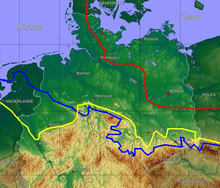
Back تجلد إلستر Arabic Elster-istiden Danish Elster-Kaltzeit German Elster-jääkausi Finnish Glaciation elstérienne French Elster (glasial) NB Glaciațiunea Elster Romanian Elster (glaciál) Slovak


red line = extent of the Weichselian glaciation;
yellow line = extent of the Saale glaciation;
blue line = extent of the Elster glaciation
The Elster glaciation (German: Elster-Kaltzeit, Elster-Glazial or Elster-Zeit) or, less commonly, the Elsterian glaciation, in the older and popular scientific literature also called the Elster Ice Age (Elster-Eiszeit), is the oldest known ice age that resulted in the large-scale glaciation of North Germany and other parts of Europe. It took place approximately 500,000–400,000 years ago. It succeeded a long period of rather warmer average temperatures, the Cromerian Complex. The Elster was followed by the Holstein interglacial, which was followed Saale glaciation. The glacial period is named after the White Elster, a right tributary of the Saale.[1]
© MMXXIII Rich X Search. We shall prevail. All rights reserved. Rich X Search